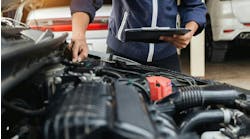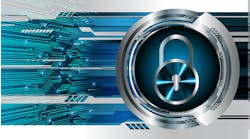In an earlier article we discussed how Advanced Driver-Assistance Systems (or ADAS) seemed to be everywhere we turned. TV commercials, print ads, tool sales pitches for scan tools and calibration equipment are all a buzz about this latest “it” topic. The first part (of this two-part series) introduced the different levels of autonomy defined by SAE. We discussed some of the fundamental systems and how through sensor fusion, they integrated. Moreover, it was discussed how it was of the utmost importance, to have the proper information as to the when, where, and how to calibrate these mission-critical safety systems. There is a continuum in the modern automotive industry between OE tooling and aftermarket systems.
Hopefully, the takeaway from the part 1 article is that this technology is not a red herring (like the 42- volt systems of the past) but, is here to stay and provides us in the automotive service industry, another revenue stream, at a time when what so many other previous revenue streams afforded us, are fading away! We merely need to tool up, train up, and educate ourselves on these high-tech systems that have become standard equipment on both higher-end and base model, newer vehicles.
Let’s get after it!
In addition to being an automotive training instructor, I own and operate a mobile automotive diagnostics and programming company (EZ Diagnostic Solutions), which specializes in serving repair shops, fleets, and especially collision repair centers. Each year our workload becomes more and more focused on collision repair centers. This is largely driven by the greatly increased number of vehicles that are equipped with ADAS safety systems and, that oftentimes need to be calibrated post-collision repair, to ensure they have been restored to safe, pre-loss condition. Our phone rings regularly with questions about lights being on in the dash (MILs), prompts on the driver's information center (DIC), loss of ADAS functionality or more commonly, questions regarding potentially required-calibration for any particular system.” So, the question of when is indeed, one of the most important ones, when working on ADAS equipped vehicles!
This is where I believe the information/knowledge is power. I prefer and subscribe to many OEM service information systems. For me, it is part of the modern cost of doing business (CODB). I believe no one knows the OE ADAS systems better than the original equipment manufacturer or OEM. Many OEMs have service information (SI) available at a very affordable short-term subscription. There are also service information providers that purchase, copy and paste the actual OEM SI procedures. I ALWAYS check the OEM SI procedure before performing any calibrations. I would recommend this especially if you are using an aftermarket tool that incorporates the procedure in the scan tool, as functions can be erroneous, omitted, or lost in translation.
The “when” to perform calibrations is kind of obvious when components like the millimeter-wave radar unit is physically replaced. But, what about when a bumper cover is simply removed to repair a cracked headlight, or suspension work and/or wheel alignment work has been performed, or how about just a simple battery disconnect? This is about knowing how and where to find the appropriate and accurate information and, it is key. I am also a firm believer in performing pre and post scans on vehicles we service, preferably with an OE scan tool. This is two-fold. First, it gives the technician valuable information and documentation of a baseline, at the beginning of the repair. Secondly, it often will help to guide the technician to what ADAS systems (and subsystems) were affected an might require more research and attention. The post-scan gives us documentation that the vehicle left with a clean bill of health. So where would start that information search?
Information is key
They are some awesome non-OEM websites that can help point us in the right direction. I like the website — www.oem1stop.com. It is a great centralized portal to point the technician to the OEMs’ website with the click of a mouse! Also, there are valuable OEM position statements regarding SRS wiring repair, when OE glass is required or even if the forward-looking radar must be recalibrated for something as simple as a front bumper cover removal! Another great source of information especially for (but not limited to) collision repair centers, is www.i-car.com (Figure 1).
This a great source of the where and when to perform the necessary ADAS calibrations. Moreover, it is a great place to educate oneself on the operation and repair of vehicles equipped with these mission-critical systems. On the I-CAR site, the technician or service writer can do a quick OEM ADAS Calibration Requirements Search to get a vehicle-specific idea of the systems the vehicle could be equipped with, as well as the componentry, the locations, and the calibrations requirements for the ADAS equipment (Figure 2). This system is easy to navigate and gives valuable information about where and when to calibrate a particular ADAS system. Let’s use an example of a 2018 Honda Accord Adaptive Cruise Control, or ACC (Figure 3).
The search matrix quickly identifies that this system works off the millimeter-wave radar sensor (or MMWR, which is the component that determines the distance from the vehicle in front of it). With a couple of clicks of the mouse, one can determine what components are involved and the systems that are affected. Furthermore, it explains in clear terms as to when calibration of the MMWR unit is required. For example, if the unit has been removed or replaced, if there was impact within 300mm of the unit, if an airbag deployed, or if something as simple as a wheel alignment was performed. Another handy feature is that is the search matrix will indicate whether the vehicle will set DTCs or turn on a MIL, whether a scan tool will be required to calibrate, and whether special tools are required. I am a big fan of where one can glean a lot of information in one centralized location; the I-CAR website does this, thoroughly and simply.
Let us look at the OEM SI to figure out the how, where, and when to calibrate the ACC system. This is for the same 2018 Honda Accord. Honda publishes a great document that is known as a Job Aid for Aiming Driver Support Systems. The most recent publication is April 2020, which supersedes the April 2019 document. This also illustrates the need to make sure your information is up-to-date and how in the ADAS world, change is constant. I was able to find this information while logged into one of the two Honda OEM SI options. They are called Service Express or Service Information System (SIS). Both are located at techinfo.honda.com. SIS is available for $25 a day. A quick google search revealed a downloadable pdf version as well. I would STRONGLY suggest downloading and saving this valuable service document. The OEM SI 29-page document details where the ADAS components are located and gives precise details as to when calibration is required. But, most importantly, lists the OE tool part numbers and pictures of the tools required for the job. If a shop was interested in doing ADAS calibrations, this would give you an idea of the tools required to service Honda vehicles. So, in the case of the 2018 Honda Accord ACC, if the MMWR component was removed or replaced, an airbag deployed, was involved in a collision (where the structural repair was done), wheel alignment was performed, or if any DTC’s set (such as P2583-xx), a recalibration or aiming of the MMWR is required. The Job Aid lists the tools as follows:
-07AAJ-TK8A100 stand
-07AAJ-STKA200 reflector
-07AAJ-STKA210 alignment set
The tools are required to perform the ACC recalibration. The Job Aid does not offer how to perform the calibration and is not a substitute for the appropriate SI regarding how to perform the calibration. In addition to the above-listed tools, you will need a tape measure (metric scale preferred), some painter's tape, a felt tip marker (or ballpoint pen), some string and, a capable scan tool (my business model is to use the OE scan tool, the i-HDS).
I always suggest consulting OE SI or a service information system that copy/pastes OE SI on the calibration of ADAS systems. Often, crucial details change from year-to-year and model-to-model. Here is a suggested pathway. Go to http://www.oem1stop.com and select the Honda icon. This leads to the Honda SIS website. Select your subscription and pay for it. Then, simply log in. Build the vehicle by entering the year/model and a searchable term. In this case, we will use "radar." Perhaps I had a DTC (such as P2583). I would enter that in the search box and the diagnostic troubleshooting measures would appear. All the instances of the term radar that pertain to it, will be displayed. Millimeter-wave radar aiming is selected and the document is displayed. It starts with the special tools required to perform the calibration. Next, there is information regarding when to perform the MMWR aiming/calibration, followed by a specific amount of space required to execute the procedure. In this case, the amount of space required in front of the vehicle is 10 m (33 ft), measured from the front bumper. 4 m (13 ft) in width, 1.5 m (4.9 ft) in height, measured from the floor.
Next, there is a section on the setup of the lines or grids (Figure 4). The first step is written in blue (representing a hyperlink) to a prerequisite section. This is needed for the setup of the lines and determining the centerline for aiming. I like to think of it as building a box, squaring the box with the vehicle and determining the true centerline of the vehicle, projecting it forward. This centerline is critical for the calibration! This is also why is it imperative that the trust angle of the vehicle is correct, and wheel alignment is often required before the MMWR calibration (or aiming) especially, if the vehicle was involved in a collision. This is where technicians tend to over complicate things.
It’s geometry class all over again
To be successful and proficient in ADAS calibrations, one much have good reading skills and the ability to thoroughly follow directions. Paying attention to detail is critical, as well. At the end of the day, this is just that same special oriented math you learned in high school geometry!
So, now that you have set up your lines/grids square, to the vehicle and determined your centerline (built your box), you now must place the target in front of the vehicle. The target is a triangular-shaped device with a pointer on the back of it, that slides on to the stand, which is made of PCV (Figure 5). Before placing the target in front of the vehicle, the target height needs to be configured. The pointer that is on the opposite side of the triangle is placed up against the bottom edge of the MMWR unit. This will be done after the radar cover bezel is removed from the lower bumper cover, allowing access to the MMWR unit. You’ll then draw a reference line with a pencil (or use a piece of tape) at the top of the target collar indicated at reference Y. Now, raise the triangle 22mm to establish reference point Y1. The triangle target is now at the proper height to calibrate the MMWR unit (Figure 6). Before the target placement at point D (outlined in the setup), prepare to aim/calibrate the MMWR unit. As, per Honda SI, the steps are as follows (Figure 7):
1.Connect the HDS.
NOTE: Keep the aiming target away from the vehicle until you are instructed in a later step. Make sure that the front license plate frame is removed if equipped.
2. Check for DTCs with the HDS.
NOTE: Troubleshoot any DTCs first before proceeding. If DTC P2583-54 is indicated, proceed with the aiming procedure.
3. In the DRIVING SUPPORT MENU, select INTEGRATED DRIVER SUPPORT SYSTEM, ADJUSTMENT, then Radar Aiming and follow the screen prompts.
4. Press ENTER on the HDS to enter the aiming mode.
NOTE: The ACC and LKAS indicators (amber) blink when aiming mode is activated.
5. The MID will indicate the number 4 for a few seconds, then displays NO TARGET.
6. Make sure the MID indicates NO TARGET on the display (Figure 8).
NOTE: If NO TARGET is not indicated, the stand set is placed in front of the vehicle or there is an unwanted radar reflection in front of the vehicle, in the range of the radar. Make sure the stand set is set aside away from the range of the radar until you are instructed to place it in front of the vehicle. If you are still getting an unwanted radar reflection, stack tires about 1.5 m (4.9 ft) in height in front of either the immovable object, such as a pole or in front of any object causing the unwanted reflections. The tires will block the radar reflections. Make sure NO TARGET appears on the MID. If it still does not appear, move the vehicle to a different location until NO TARGET appears on the MID.
Now place the triangle target and stand at point D, measured out earlier. This is 4000mm from the centerline of the front wheels as well as the line that bisects those lines, and the centerline of the vehicle, projected forward. There is a hole in the stand that corresponds with the face of the triangle. It must line up with point D. Now select enter on the scan tool, to calculate the alignment angles used to aim the MMWR. The tolerances are 0 +/- 0.1 degrees, for both the horizontal and vertical angles. If either angle is out-of-specification the technician must adjust by rotating the adjustment bolts with a 3.5 mm driver. You can usually watch (in real-time) the adjustment, by viewing the data on the scan tool, provided the radar zone to the target is not obstructed (Figure 9). If the zone is obstructed, 12.8 degrees will be displayed. If 12.8 degrees is displayed for longer than 15 seconds the aiming process will stop. After the horizontal and vertical alignment angles are within a specified range, select enter on the scan tool. This will record the angles to the MMWR unit. The scan tool should now display, “the radar aiming has been completed” (Figure 10). Enter is selected one more time and the ignition is switched to the locked position. The radar cover can be reinstalled and the vehicle should be test driven.
Cover your tail!
I also like to document to process for liability’s sake. I would suggest keeping screenshots of the scan tool’s horizontal and vertical angles, both before and after adjustment. Capture the screen indicating the “radar aiming completed,” as well. Programs like Google Slides, Paint, or the Window Snipping tool work well for this. I would also suggest taking pictures of the target-setup. Include the vehicle and its license plate. Ensure a time date/stamp is exhibited and keep a copy for your records. A verification test drive should be performed on any ADAS calibrations before returning the vehicle to the customer.
ADAS systems are here to stay and are becoming more and more prevalent, on the vehicles that are coming into your bays. While the actions involving a vehicle’s functionality vary from car-to-car, they all seem like they are from a sci-fi movie. Many of their calibrations may require some specialized tooling but ultimately, it just good old-fashioned geometry. Following detailed instructions from quality service information and attention-to-detail is absolutely critical. It’s not rocket science, it just requires us to do what we have always done — research, train-up and adapt to the changes in our industry!!


